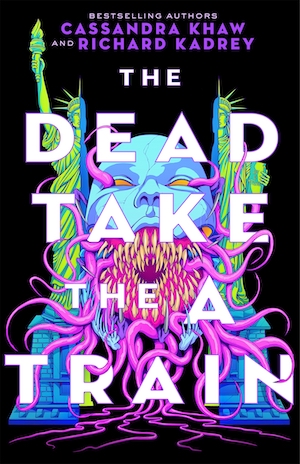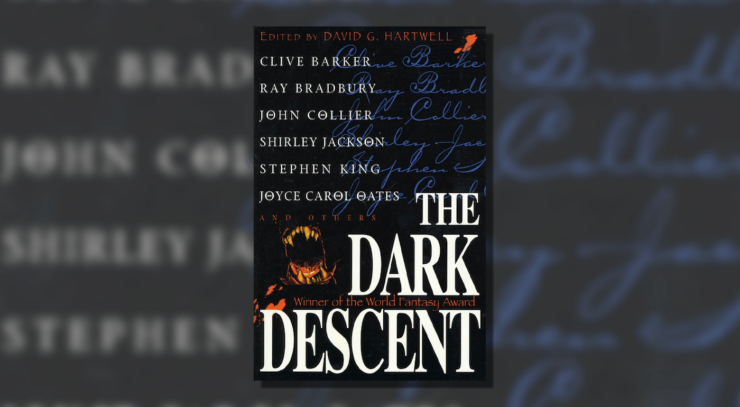Welcome back to Dissecting The Dark Descent, where we lovingly delve into the guts of David Hartwell’s seminal 1987 anthology story by story, and in the process, explore the underpinnings of a genre we all love. For an in-depth introduction, here’s the intro post.
At first glance, it seems odd for David Hartwell to characterize “The Whimper of Whipped Dogs,” Harlan Ellison’s brutally pessimistic portrait of existential horror and urban misery based on apocryphal accounts of the Kitty Genovese murder, as a moral allegory. It’s a story where the evil is pervasive and all-encompassing, where the existential threat is too large to be reckoned with, and where even the final moments of catharsis are (in context) resoundingly pessimistic. It would be easy to assume there is no moral, just an unrelenting indictment of the senseless terror and torture of modern urban living.
While it’s true “Whimper” is pessimistic, the ceaseless torture that the childish god at the center of the story—and indeed, the story itself—inflicts upon its denizens does in fact have a point: It’s a chilling and twisted parable of how systems of abuse and control gain compliance from their subjects. Ellison’s work, while couched in a pessimistic snarl, is a story that uses the themes of existential and urban horror to explore the wider question of exactly how an individual—even one filled with empathy and good intentions—can find themselves caught up in the torture and death of their fellow human beings.
[As a prelude to our discussion, I would like to first offer a warning. While this series has delved into dark subject matter before, “The Whimper of Whipped Dogs” is our first discussion of what could be called “extreme horror.” The following piece has content warnings for mentions of violence, misogyny, harassment, discussions of a brutal real life homicide, torture, and abuse.]
On a foggy night in New York City, Beth and several of her neighbors witness a brutal stabbing outside their apartment complex. As a young woman cries out, desperately tries to fight off her attacker, and finally succumbs, Beth sees two sets of eyes through the fog: A man in a nearby apartment watching her intently, and an “ancient yet childish” set of eyes within the fog itself watching the murder with intense curiosity. Traumatized by the event and the seeming lack of a response from her neighbors, Beth is beset from within and without by a number of forces ranging from her own guilt, simple bad luck and bad interactions, and Ray, the curious and misanthropic young man who watched her as she watched the stabbing. As New York (and Ray) becomes more oppressive and horrifying, Beth is forced into a choice with her life and sanity at stake. For those eyes belong to a hungry thing, and it will either see Beth fall in line, or see her destroyed.
The horror in “The Whimper of Whipped Dogs” doesn’t come from how violent, sadistic, and downright childish the god of New York City is. It’s how it conditions people to accept its “overtures” and violently punishes them for stepping out of line until they’re too terrified to resist. As Beth reacts with horror to the apathy and unkindness around her, the city throws torment after torment in her path. With each new horror (which range from mere inconvenience to outright street harassment), Beth changes from someone with a strong sense of morality and capacity for horror to a foulmouthed and apathetic creature who, at the last possible moment, finally breaks—as she is about to die at the hands of a burglar, she instead professes her allegiance to the new god, offering up her attacker as a sacrifice. Her very existence in this environment warps her brain until she becomes the very thing the City wants her to be, battering and hounding her until she steps back into line, another good little denizen of its sadistic domain.
It’s absolutely heartrending to witness, too. Beth’s destruction is both relentless and relatable, with next to no evidence of the supernatural outside the occasional flash of glowing eyes— everything that happens to her ranks among the numerous difficulties, hostilities, or downright awful things regularly experience by women in heavily patriarchal environments, running the gamut from a hideous interaction at a lunch counter where Beth finds herself uses a certain profanity beginning with “f” to a waitress who refuses to fix her order (“It was the first time in her life that Beth had said that word aloud.”) to repeated and routine street harassment from a variety of faceless men. Ellison forces you to watch the slow, methodical breaking of a person by systems that have no doubt become even more familiar to readers with each passing decade since the story’s publication, the horror coming not so much from the torture itself as from the all-encompassing existential threat that Beth incurs for merely resisting and refusing to go along with the City’s desires.
Most insidiously, the more she changes, the more the City rewards her for that change. Beth finds herself getting more work, she’s accepted by the informal death cult in her apartment complex, and she even ends the story knowing that, having sacrificed another person to the City, she’s “safe.” She’s also comforted by Ray, the closest thing the City has to an avatar and prophet, who spends most of the story abusing her and subjecting her to misogynist rants, but now shows uncharacteristic tenderness in those final moments. In Beth’s eyes, being broken and corrupted, being turned into another denizen of the City and its God, is a happy ending. There’s a palpable sense of relief at the end, that the torture has finally stopped and Beth will live to see another day.
Buy the Book


The Dead Take the A Train
There’s a twisted sense of catharsis to the final scenes, similar to the denouement of a horror movie: The heroine lives, everyone seems relieved, and she’s comforted in the aftermath of a sickeningly brutal home invasion-gone-wrong. Yet even the attacker in the home invasion is someone beaten down by the City, a man clearly involved in a desperate and poorly thought-out robbery, another marginalized and oppressed denizen forced into the City’s gladiatorial arena. That final image, of one person beaten down by the city attacking another, both essentially pawns in a larger system, with the burglar being described as “a whipped dog whimpering,” has all the elements of a happy ending (heroine beaten but alive, male lead there for comfort and…other things, an overwhelming feeling of safety), but contextually, the reader knows the truth.
It’s in this intense weaponization of that moment of relief that the story delivers its final indictment. Sure, the horror and torture have passed, the threats have stopped, and the heroine will live to see another day. Beth only does so because she finally gives in and crosses a line, making her choice between the roles of victim and willing participant. Because that’s what systems of oppression do— they seek to either crush you underneath them (a system of violence can always use more horror stories, victims, and martyrs, after all), or make you a willing and complicit participant. There are consequences for both sides, of course. If you’re a victim, you’ll find yourself tortured to death by existential threats as it erodes your resistance, will to live, and ability to care about yourself or others. If you participate, you’ll find yourself living a charmed life with increasing levels of privilege, only troubled by guilt and the need to perform constantly to prove that you’re not complicit (as Beth does at the end, rehearsing her story for the police).
That catharsis—when paired with the context that Beth is, at the end of the story, finally a broken mess willing to embrace the appalling God of New York City and accept the rewards for her compliance—is what drives home the moral. Ellison doesn’t put the blame on Beth for finally accepting her fate, but instead on the horrifying systems that finally broke her and compelled her to make obeisance and sacrifice to them. The fury of “Whimper” isn’t directed at a single person pushed past their breaking point, but an indictment of the forces that so thoroughly broke her, victimizing her until she did exactly what they wanted. Beth is average, but the torture inflicted on her at every level is so great that eventually she complies to save herself. In that one selfish moment, Beth becomes one of the oppressors. In that moment, the oppressive, torturous system around her finally wins and turns her into another cog in its machine. It’s terrifying to think about.
But it could happen to just about anyone. After all, who wouldn’t want the torture to stop?
Please join us next week for Nathaniel Hawthorne’s classic of small-village Satanism “Young Goodman Brown”
Sam Reader is a literary critic and book reviewer currently haunting the northeast United States. Apart from here at Tor.com, their writing can be found archived at The Barnes and Noble Science Fiction and Fantasy Book Blog and Tor Nightfire, and live at Ginger Nuts of Horror, GamerJournalist, and their personal site, strangelibrary.com. In their spare time, they drink way too much coffee, hoard secondhand books, and try not to upset people too much.










